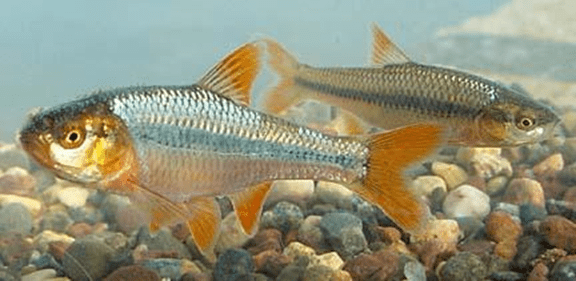Draft Recovery Plan for the Topeka Shiner Available for Review

U.S. Fish and Wildlife Service Seeks Public Comment
DENVER – In the late 1990s, the Topeka shiner, a native fish of the Great Plains, was in trouble. Once common across its range, the tiny three-inch minnow has faced impacts associated with the health of its habitat, predation, sedimentation, and changes in water quality. As a result, the fish’s populations declined almost 70 percent over 50 years. The species was listed under the Endangered Species Act (ESA) in 1998.
Under the ESA, in coordination with state wildlife agency experts and other conservation partners, the Service has completed a draft recovery plan for the Topeka shiner, which is now available for public review. A recovery plan is a guidebook towards a shared goal of ensuring the long-term survival of a species in the wild. It outlines site-specific management actions that contribute to the recovery of the species, describes the time and cost estimates for the implementation of those actions, and outlines measurable criteria for delisting. Recovery plans support federal, state, tribal, and private cooperators seeking to advance the recovery of listed species, but they are not regulatory documents.

The Topeka shiner lives in slow-moving, naturally winding prairie streams and can be found in isolated pockets of South Dakota, Minnesota, Nebraska, Iowa, Kansas, and Missouri. Its draft recovery plan calls for multiple resilient groups of populations (also known as population complexes) to be distributed across the species’ range. To achieve recovery, these population complexes should each feature a sufficient number of individuals, suitable habitat conditions, and some level of connectivity to one another to allow for recolonization. The Service will continue to grow its long-term conservation partnerships with state wildlife agencies, natural resource managers, ranchers, farmers, and other groups to achieve recovery.
The draft recovery plan is available today for public inspection and will publish tomorrow in the Federal Register. It will also be available on https://ecos.fws.gov/. The Service will accept public comments on the draft plan for 60-days after publication. Interested parties can submit comments electronically to the following email address: kansases@fws.gov. Comments will also be accepted via U.S. mail or hand-delivery to: Field Supervisor, Kansas Ecological Services Field Office, U.S. Fish and Wildlife Service, 2609 Anderson Avenue, Manhattan, KS 66502.
To learn more about the Topeka shiner, visit https://www.fws.gov/mountain-prairie/es/topekaShiner.php.
The mission of the U.S. Fish and Wildlife Service is working with others to conserve, protect, and enhance fish, wildlife, plants, and their habitats for the continuing benefit of the American people. For more information on our work and the people who make it happen in the West, visit our website, connect with us on Instagram and Facebook, follow us on Twitter, watch our YouTube channel, and download public domain photos from Flickr.
